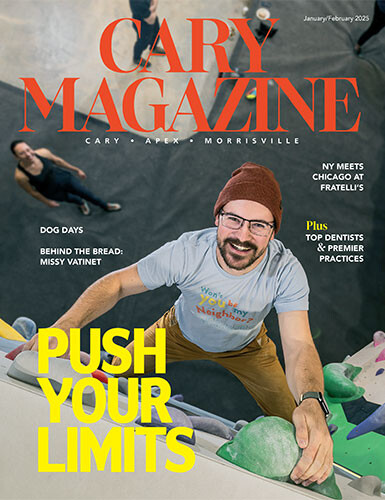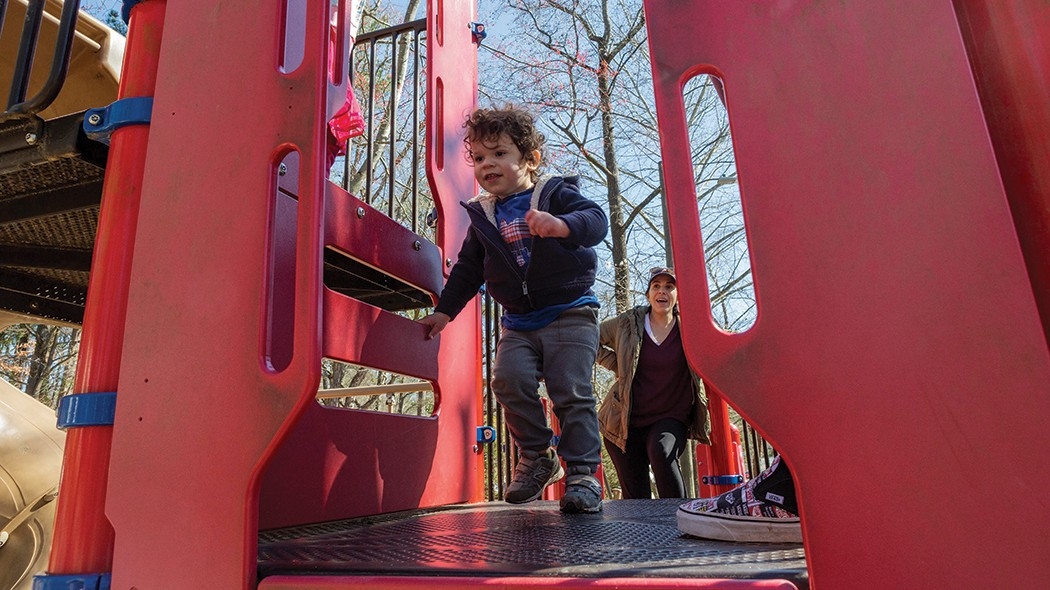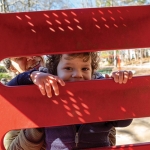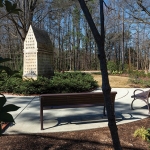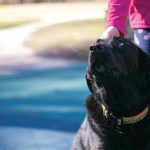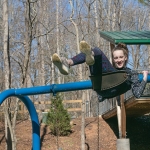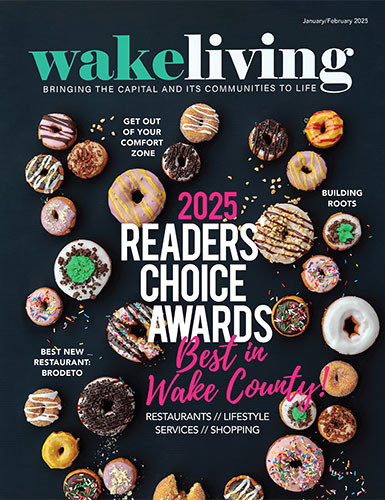After World War II left entire European cities in rubble, officials transformed blasted plots of land into small parks. The green spaces provided a spot for outdoor recreation, and helped restore a sense of normalcy to the war-torn communities. In the 1950s, the idea of these “vest pocket parks” spread to the United States, particularly in large urban areas.
As Western Wake has grown, and the towns have become denser, the need for small parks and open spaces has increased. Green oases have sprung up in subdivisions and developments where land is otherwise scarce and expensive.
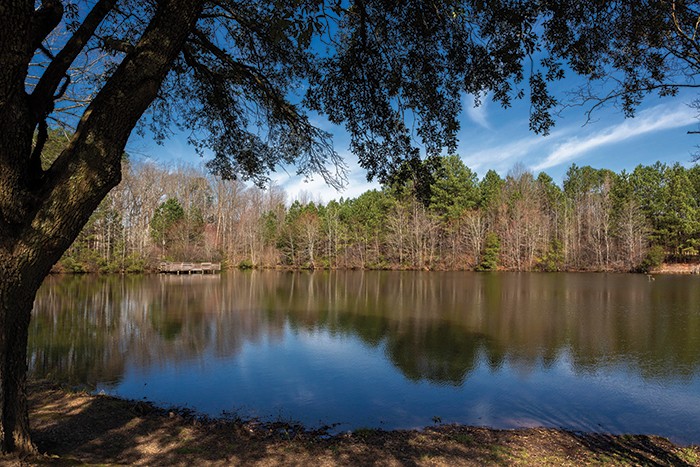
With multiple places to stop and view the lake, Seagroves Farm Park in Apex is the perfect spot for a scenic hike or stroll with your dog.
“Admittedly, the town, over the past 20 years, has invested in larger parks,” said Doug McRainey, director of Cary’s parks, recreation and cultural resources department. “We have preferred to have fewer, but larger parks for maintenance purposes. It has only been in the past few years that we have considered investing in smaller parks within Cary’s downtown area.”
More than 30 public parks — covering over 2,688 acres — are in Cary, and five of them are considered pocket parks. Morrisville has three of these small parks, and Apex is home to five.
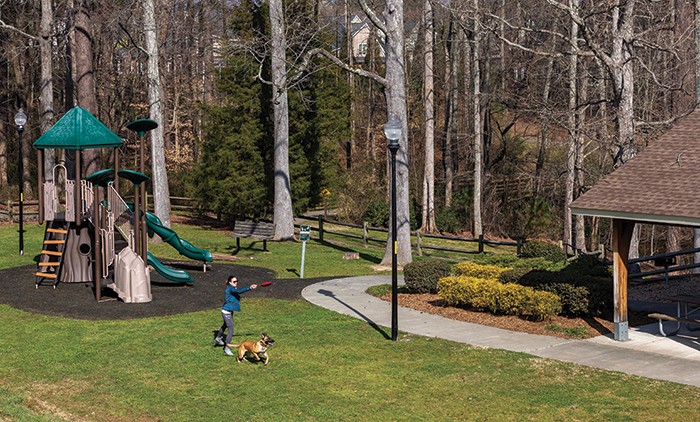
Alejandra Rios tosses the Frisbee for Mara, her Belgian Malinois, at Seagroves Farm Park.
Cary
Cary resident Diana Agius watched her two sons grow up within walking distance of MacDonald Woods Park, where they played pickup basketball games and met friends after school. Now that her sons are grown, she brings her grandson to the park when he is in town.
“It’s a young child’s dream,” she said. “He climbed, swung, rode and slid to his heart’s content. It’s big enough, and there’s a lot for kids to choose from in terms of variety and difficulty of activities.”
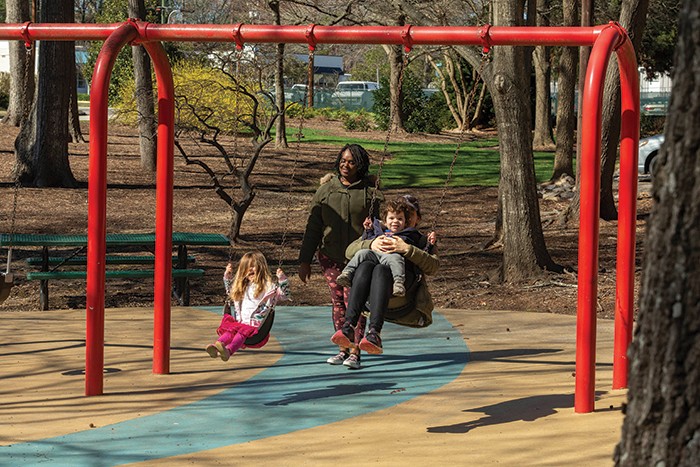
Greg and Kiersten Duffy moved to the area about three years ago, and a big plus was access to the park and greenways. It reminded them of growing up in the North, where schools and parks are part of the neighborhoods.
“Every day after school, all the kids run to the park,” she said. “It’s really cool to see them so excited to come and play outside — it’s how we remember growing up.”
The Duffys’ two children are 6 months and 13, and there is something for each of them to enjoy at the park — whether that’s throwing rocks in the stream or swinging on the swings.
- Matthew Murphy takes a peek through part of the playground at Urban Park in Cary.
- Kay Struffolino Park in downtown Cary is one of the newest parks in the town, named after long-time resident and active volunteer in the Town of Cary.
- Cary Pup Cam enjoys walking at MacDonald Woods Park.
- Kaylee Duffy, 13, swings at MacDonald Woods Park. Kaylee has been coming to the park with her parents and friends since her family moved to the neighborhood three years ago.
- Four-year-old Natalie Steinhoff finishes her slide with a smile at Urban Park in Cary.
Morrisville
With an increase of 5,000 residents from 2010 to 2015, Morrisville suburbs and apartment complexes have popped up everywhere. But, with more homes, there is less open space for outdoor recreation.
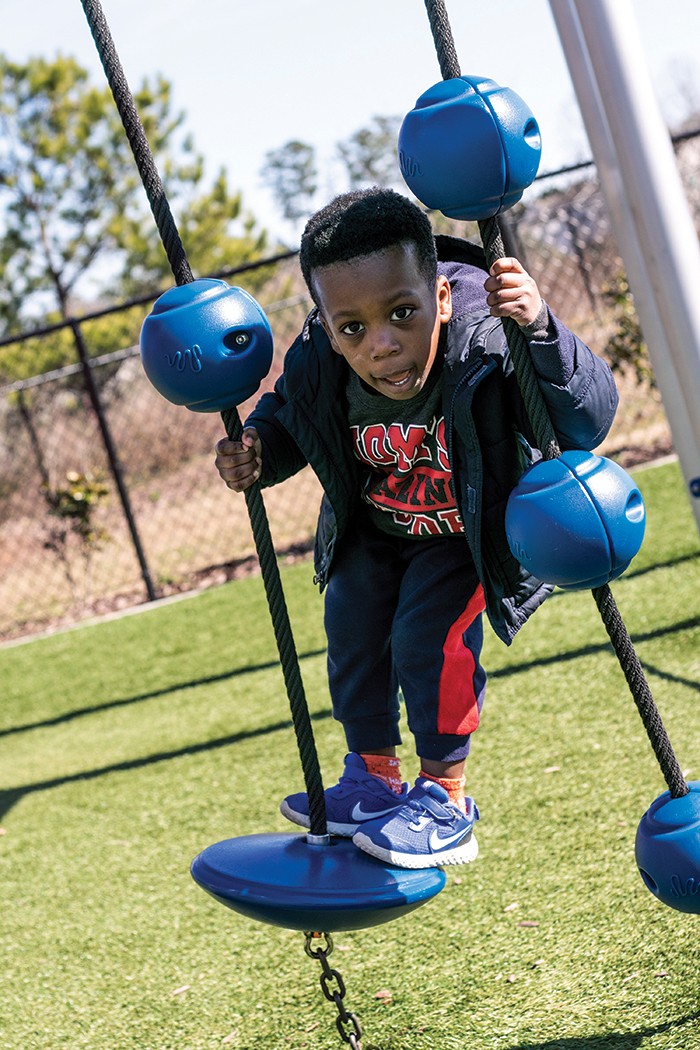
Danny Jumbo, 3, plays on the playground at North West Park. Danny and his brother David visit the park on a weekly basis with their parents.
“There’s not much open space where kids and families can go throw a Frisbee or baseball without feeling like you’re throwing it into your neighbor’s yard,” said Jerry Allen, director of Morrisville’s parks, recreation and cultural resources department.
The town is working to create more green spaces, providing a place for neighbors to socialize and kids to play — especially those who may not have yards or close proximity to larger parks.
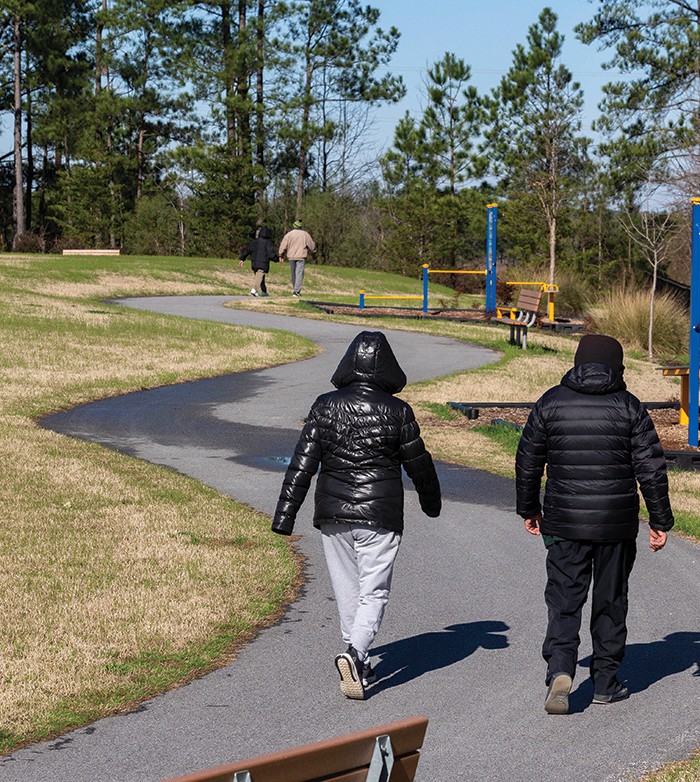
A couple takes a stroll in North West Park in Morrisville.
Tieska Jumbo moved to Morrisville from Jacksonville, Fla., with her husband and sons last year. With two boys, at 3 and 5 years old, going to various parks in Cary and Morrisville is a weekly adventure.
“They all have something different,” Jumbo said, as her boys climbed on the playground at North West Park. “Some of them have the traditional slides and swings, and then others have none of that, but they’ve got other things like ropes and things to climb on.”
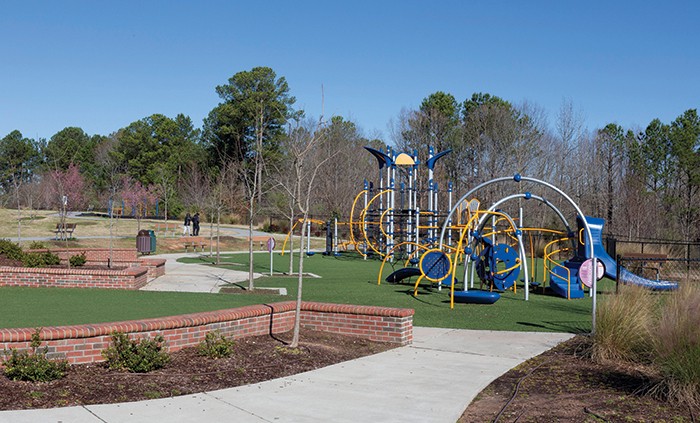
North West Park in Morrisville offers multiple playgrounds, a walking track and an open-play field.
Pocket parks tend to have fewer amenities than large metro parks, but their convenience and smaller size are a perk for some.
“While our children are small, we need to keep them contained,” Jumbo said. “They can go the length of the park and I can still see them, so I can let them be freer.”
Apex
In Apex, the parks and recreation department is working to make the town more connected by developing small parks and installing more greenways to encourage more walking or biking, says Angela Reincke, Apex parks and greenways planner.
Due to their more urban or neighborhood setting and natural lack of parking, pocket parks further the department’s vision.
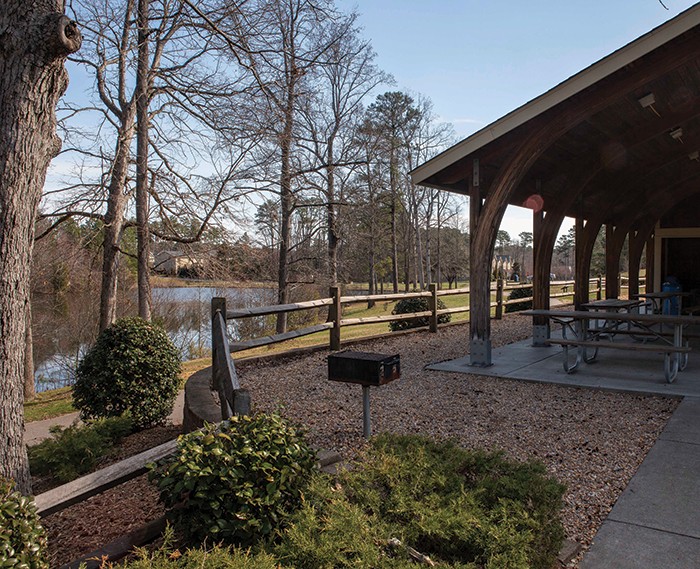
The 1.5-acre Seagroves Farm Park in Apex has a shelter and grill available for rent, making it a great spot to host parties and picnics.
“If somebody wanted to experience different types of playgrounds or play features around town, the small parks are each a little bit different and unique. You can make a small outing out of going and exploring a new one,” Reincke said.
“We like to think that we provide a park that meets an interest or a need or activity for everybody of all ages and all abilities.”
Apex resident Denise Garner enjoys walking her dog Gypsy in nearby Seagroves Farm Park, where the walking trail passes by ponds and goes over bridges.
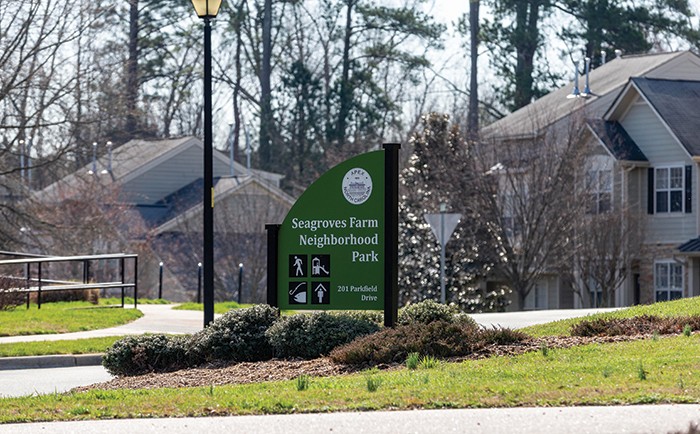
“It’s so nice,” she said. “Everyone is so friendly from the town.”
Contrary to the typical sidewalk, Garner appreciates the dog waste stations, which provide bags and trash cans.
For these smaller parks, it’s the little things that make them worth coming back to.
“People are so busy today, and people are so wrapped up. They’re always in a rush; they’re always in traffic,” said John Brown, director of Apex parks, recreation and cultural resources. “It’s a great opportunity to get away from that and to relax in a natural setting.”
Cary
Heater Park: 400 S West St.
Urban Park: 414 E Chatham St.
Kay Struffolino Park: 601 Kildaire Farm Road
North Cary Park: 1100 Norwell Blvd.
MacDonald Woods Park: 1601 Seabrook Ave.
Morrisville
North West Park: 2114-2180 Louis Stephens Drive
Ruritan Park: 212 Page St.
Crabtree Creek Nature Park: Keybridge Drive off of NC-54
Apex
Clairmont Park: 801 E. Chatham St.
Kelly Glen Park: 1701 Kelly Glen Lane, off of West Kelly Glen Drive
Seagroves Farm Park: 201 Parkfield Drive
Sue Helton Park: 201 Matney Lane, inside the Perry Farms subdivision
West Street Park: 108 West St., at West and First streets
- Art of Aging Gracefully
- In the Mix
- A Pocket Full of Parks
- In Healing Color
- Small Business Spotlight: Rush Cycle
- Nonprofit Spotlight: Alliance Medical Ministry
- Remembering Rosenwald
- From the Editor: April 2020
- Green Scene
- Liquid Assets: No’Lasses from Fair Game Beverage Co.
- Liquid Assets: Vitruvius IPA from Craftboro Brewing Depot
- Garden Adventurer: Fringe Gardening
